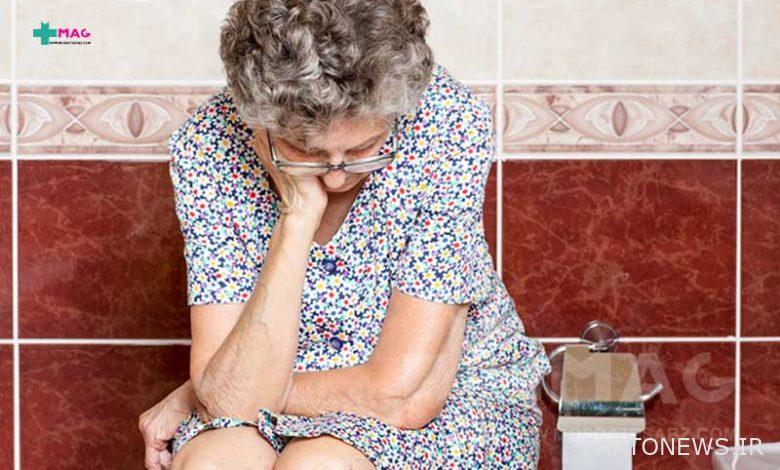Constipation in the elderly; Reasons and how to treat

Chronic constipation is very common in adults over 60 years old; So that 50% of people who are in nursing homes complain of constipation. If constipation is not permanent, small lifestyle changes, such as adding fiber to the diet and increasing physical activity, can resolve the problem. But if constipation becomes chronic, some medicines such as laxatives must be used. In this article, we will first discuss the cause of constipation in the elderly and then we will mention its treatment methods.
What is constipation?
When a person has only 3 or less bowel movements in a week, it means he is constipated. Constipation is also a condition in which a person cannot empty his bowels completely. Many people say they are constipated even when they have to strain to have a bowel movement. Constipation can happen to everyone from time to time, but when it occurs regularly and continuously, it becomes a problem.
When stool remains in the large intestine or colon for a long time, it becomes hard and dry, making it more difficult to pass. About 16% of adults experience chronic constipation. But this percentage reaches one third of the population in people over 60 years old, which is considered to be a high number. One of the best ways to treat constipation is to use anti-constipation pills.
Types of constipation in the elderly
In general, we have two types of constipation: primary and secondary, which may occur at any age and are not only for the elderly:
Primary constipation
Primary constipation is also called functional constipation. This type of constipation occurs when there is a disturbance in the bowel function. It means that the cause of constipation in this case is not caused by a disease or a specific drug. Primary constipation is divided into 3 categories: normal constipation, slow transit constipation and defecation disorders. A person may have several types of constipation at the same time. Natural constipation is the most common type and occurs when your stools move with regular frequency but are difficult to pass.
In slow transit constipation, the bowel moves the stool towards emptying with a delay for some reason. Most people with metabolic disorders such as diabetes and hypothyroidism suffer from this type of primary constipation. In the type related to defecation disorders, the problem in the rectal muscles reduces the urge to defecate and causes stool to form without emptying into the large intestine.
Secondary constipation
Another type of constipation in the elderly and all people in general is secondary constipation. Secondary constipation occurs when bowel problems are related to some physical or medical problem. Also, the use of some drugs can be considered as a cause of secondary constipation. For example:
- Taking more than 5 different drugs at the same time
- Having a chronic disease
- Mental health problems
The cause of constipation in the elderly
With age, many changes occur in the human body. The body’s internal systems slow down and lose their efficiency. On the other hand, diet and conditions and lifestyle may also change. As we said, from the age of 60 onwards, the problem of constipation is very common among the general public, both men and women. Some of the causes of constipation in the elderly include:
- Reduced mobility and physical activity
- Suffering from chronic diseases
- dehydration
- Not consuming enough food and water

On the other hand, with age, structural changes occur in the body. Like:
- Thickening of the colon
- Anus narrowing
- Rectocele (weakening of the back wall of the tissue between the intestine and the vagina in women)
- hemorrhoids
- Reducing the efficiency of the digestive system
- Movement disorders
- Intestinal obstruction and perforation
Preventing constipation in the elderly
If the elderly have several different diseases and take many medications, constipation may be inevitable. But the possibility of constipation can be reduced by using the following solutions:
- Drink a lot of water
- Increase physical activity
- Doing sports exercises regularly
- Include 25 to 35 grams of fiber in your daily diet
- Making time (regularly) to go to the bathroom after every meal
The best foods to treat constipation in the elderly
Adding plenty of fiber and water to your diet is the key to treating constipation. Some of the foods with high fiber are as follows:
- Oatmeal
- Whole wheat bread
- Whole grain pasta
- Lentils, peas and beans
- Berries
- Apples (with skin) and pears
- Broccoli
- peas
To treat constipation in the elderly, fast foods, fried foods, and processed foods should be avoided because these types of foods either lack fiber or have very little fiber. Dairy products and foods that are high in sugar can also increase the risk of constipation.
Treatment of constipation in the elderly
The first goal in curing constipation should be to reduce symptoms such as abdominal bloating and pain. The second goal is to have regular bowel movements and soft stools. Dietary changes and exercise are the first suggestions that doctors give to people with constipation. If it is determined that non-pharmacological methods are not effective, the doctor may examine the person. The examination is usually done in cases where hard and dry feces accumulate in the large intestine and it is difficult to expel feces.
Related posts
If the person has retained feces, this complication should be removed with an enema or manual cleaning. Be careful that these procedures should only be performed by a specialist doctor. But if the constipation is not hidden, there are other ways:
Behavioral options
Behavioral options for treating constipation in the elderly include the following:
- Planning to go to the bathroom after eating
- Using footrest during defecation
- Dedicating enough time to go to the bathroom and having enough privacy
- Not using the pelvis in bed

Drug options for immediate treatment of elderly constipation
The type of constipation should be diagnosed and then appropriate treatment should be given accordingly. Anti-constipation pills and syrups are usually available without a prescription. But if the doctor prescribes a specific medicine, the result will undoubtedly be better. There are several types of medicines to treat constipation:
Stool bulking drugs
These drugs increase the volume of stool to increase the feeling of the need to defecate in a person. Some of these drugs include:
- Methyl cellulose powder (fiber supplement): 19 grams per day
- Polycarbophil tablet: 1250 mg 1 or 4 times a day
- Psyllium fiber (metamusil): 1 teaspoon or 1 packet one to three times a day
Osmotic laxatives
Osmotic laxatives work by absorbing water into the large intestine. These types of drugs help to keep the stool soft and hydrated and make natural bowel movements easier. Examples of these drugs include:
- Lactulose solution: 15 to 30 ml per day
- Magnesium citrate solution: 150 to 300 ml as a single dose
- Magnesium hydroxide suspension: 30 to 60 ml per day
- Polyethylene glycol powder (Miralox): 17 grams per day
- Sorbitol solution: 2 to 3 tablespoons of single dose or for short-term daily use.
Stool softeners
Constipation in the elderly can also be improved with stool softener tablets. Stool softeners make it easier to pass stool. Sodium docosate capsules or colas are among these drugs.
Stimulant laxatives
Medicines that are part of stimulant laxatives help to move stool by stimulating intestinal contractions. These types of laxatives and their recommended dosage are:
- Bizocodil tablets: 5 to 15 mg per day
- Senna tablets: 15 mg per day
Do milk and dairy products cause constipation in the elderly?
Milk and dairy products can contribute to constipation; But not always. Dairy products can cause diarrhea in some people who are allergic to proteins in cow’s milk. Make a note of the foods you eat during the day to better understand which food is the cause of constipation. Then limit foods that seem to be associated with constipation.
Is constipation different in older men and older women?
Both women and men can become constipated as they age. But the risk of constipation is higher in women than in men. The reason for this issue may be related to the fact that the prevalence of pelvic floor dysfunction, which weakens the ability to move stool, is higher in women.
Effective factors in increasing the risk of constipation in the elderly
Reaching the age of 60 is a factor for increasing the risk of constipation. But there are other cases. Women are more constipated than men. People who are physically weak are also more susceptible to constipation. Other factors are also involved:
- Low fiber diet
- Inactivity or immobility
- Dehydration and dehydration
- Not consuming enough food and water
- Taking several drugs at the same time
- Insufficient time to defecate or inappropriate privacy
last word
One of the most important causes of constipation in the elderly is the age factor. There are different types of constipation that we mentioned in this article. Before constipation becomes a permanent problem in the elderly, it is better to see a doctor for its treatment. Sometimes a change in diet and increased physical activity is enough to treat constipation. But sometimes medicine must be used. In this regard, if you have any questions, you can post them in the comments section.
Please rate this article
[مجموع: ۰ میانگین: ۰]


